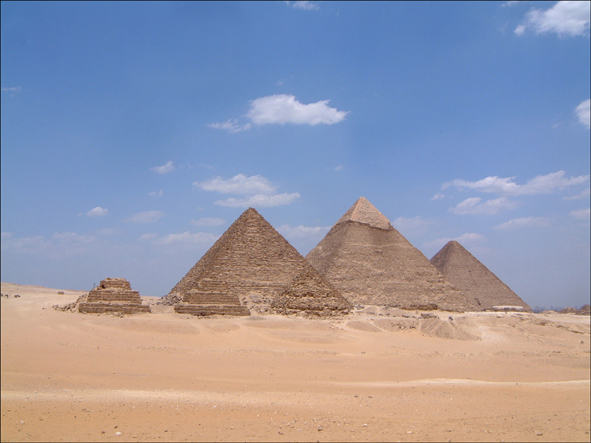![]()
![]()
ILLEGAL
FINDS REVEAL
ASTRONOMICAL CLUES
Antiquities
from illegal pit digging in Nazlet el-Samman videoed on cellphone - coffin reveals
unique astronomical imagery
Andrew Collins reports

The
Giza Plateau, next to which illegal digging claimed the lives of six people recently
and revealed priceless antiquities from ancient Egypt's illustrious past (pic
credit: Andrew Collins, copyright 2009)
Nazet el-Samman, Egypt, October 23, 2009 - Last month saw the death of six people in Nazlet el-Samman, next to Giza's famous plateau, when an illegally dug pit collapsed as treasure hunters attempted to retrieve a cache of valuable Egyptian antiquities. After the police and Egyptian officials descended on the residence, arresting two men, various items are said to have been removed from the site close to the Sphinx monument.
I now have a brief description of those antiquities, which were recorded on a cellphone video as they were carried from the residence. Although I have not personally seen the video clip, I understand it shows that:
" … mummies were discovered along with many other items … the picture of the mummy coffin is very ornate and a most unusual painting on it … the image of a crocodile over the back of the hippopotamus with a moon (not sun) above the head. A small gold statue of a crocodile and gold soldiers, were some of the items shown."
These finds sound extraordinary. The coffin's croc and hippo imagery is very likely astronomical in nature. Both creatures are depicted together in New Kingdom funerary art as sky figures among the so-called "Great Ones of the North of the Sky", equated with the 'ihmw-šk, 'Imperishable Stars', or 'Indestructible Stars'. These Great Ones are thought to represent the northern constellations associated with the place of the afterlife. The hippo is Draco, with the croc thought to be either Ursa Minor or another aspect of Draco - probably the later.
The "Great Ones of the North of Sky" started to be depicted on coffins during the First Intermediate Period, c. 2100 BC, but they did not appear in full glory until the New Kingdom, c. 1585-1087 BC, when they are found frequently on tomb walls or on sarcophagi.
The moon depicted above the croc and hippo on the coffin found at Nazlet el-Samman is a departure from the conventional sequence involving the Great Ones of the North of the Sky. It suggests a variation away from the standard imagery cited above, perhaps indicating a later tradition from either the Late Period or Graeco-Roman times.
The separate statue of the croc might suggest that the person was a devotee of Sobek, the croc god whose cult was associated with the Faiyum Oasis as welll as the city of Crocodopolis (Egyptian city of Shedyet), southwest of Memphis, where there was a major temple of Sobek. The croc god rose to prominence in the Twelfth Dynasty, about the time of the female queen Sobek-nofru, the daughter of Amenemhet III, whose name honours the god. She was the daughter of Amenemhet III, and the sister of his successor Amenemhet IV, and ruled for three years around 1800 BC. Sobek-nofru is believed to have completed the fabled labyrinth monument at Hawara in the Faiyum Oasis, following the death of her father and brother. Following her death, which wound up both the Twelfth Dynasty and the Middle Kingdom period, the cult of Sobek continued through into the Second Intermediary Period, with no less than five kings with names honouring Sobek. The croc god's cult waned thereafter, but was revived towards the end of the Eighteenth Dynasty in the New Kingdom by king Horemheb. It then probably continued on through into the reigns of Rameses I and Seti I, hence the latter's name, since the evil god Set, brother of Osiris, was seen as the father of Sobek.
That's about all I can say for the moment. I understand that Dr Zahi Hawass, the Secretary General of Egypt's Supreme Council of Antiquities, has taken charge of the investigations surrounding the bizarre happenings in Nazlet el-Samman. Yet so far there has been no official word on the discoveries, and no confirmation of earlier rumours that a lost Temple of Khufu had been found at the illegal excavations.
With all the other projects that Dr Hawass is coordinating at this time, adding another one in Nazet el-Samman makes it more unlikely that he is ready to admit the existence of Giza's cave underworld following his earlier denial of its existence back in August. This is despite the fact that I now understand that he IS aware of the natural caves, accessed via a tomb in the plateau's northern cliff face.
![]()